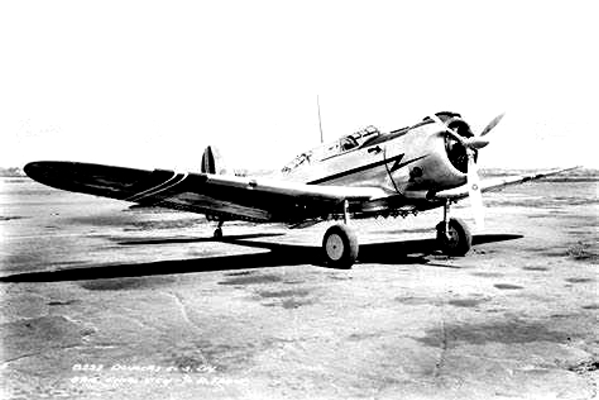


























Douglas (Northrop) 8A-5 Attack Bomber
(Douglas El Segundo Division Photo #8231 Right-Front

Douglas (Northrop) 8A-5 Attack Bomber
(Douglas El Segundo Division Photo #8233 File View-Right Side)
Overview
Douglas (Northrop) A-33/Model 8A-5
- Role: Attack aircraft
- National origin: United States
- Manufacturer: Douglas Aircraft Company
- Introduction: 1941
- Primary user: United States Army Air Corps; Norwegian Air Force
- Number built: 36
- Developed from: Northrop A-17
The Douglas A-33 (Model 8A-5) was an American attack aircraft built in small numbers during World War II. It was an updated version of the Northrop A-17, with a more powerful engine and an increased bomb load. While the A-33 was intended initially for the export market, the entire production run was taken up by the United States Army Air Corps.
Design and development
In 1932, the Northrop Corporation had been formed as a partly owned subsidiary of Douglas and by 1937, the Northrop Model 8 became known as the Douglas 8A produced in the El Segundo Division of Douglas aircraft.
The 8A-5 was powered by a 1,200 hp (895 kW) Wright R-1820-87 engine and was the most powerful and best armed of the series, with four wing mounted 0.30 in machine guns, two 0.50 in machine guns in pods below the wing, a rear-firing flexibly mounted 0.30 in gun, and the ability carry up to 2,000 lb of bombs.
Operational history
Early in 1940, the Norwegian government ordered 36 8A-5s which not had been delivered before Norway was invaded by the Germans. Completed between October 1940 and January 1941, the aircraft were delivered to a training center in Canada that had been set up for the Norwegian government-in-exile, named "Little Norway" at Toronto Island Airport, Ontario.
After the loss of two aircraft and a reassessment of the training needs now met by the use of other aircraft, the remaining 34 Model 8A-5Ps were sold to Peru. However, 31 were repossessed by the Army Air Corps at the start of World War II. These aircraft, designated A-33, were used for training, target tug, and utility duties.
Variants
- Model 8A-5
- A-33: Serial numbers: 42-13584/13601; 42-109007/109019
Operators
- Norway: Little Norway
- Peru
- United States: United States Army Air Corps
Douglas (Northrop) 8A-5 / A-33 Attack Bomber Specifications and Performance Data)
General characteristics
- Crew: 2
- Length: 32 ft 6 in (9.91 m)
- Wingspan: 47 ft 9 in (14.55 m)
- Height: 9 ft 4 in (2.84 m)
- Wing area: 363 ft² (33.7 m²)
- Airfoil: root: NACA 2215; tip: NACA 2209
- Empty weight: 5,510 lb (2,499 kg)
- Gross weight: 8,600 lb (3,901 kg)
- Max takeoff weight: 9,200 lb (4,173 kg)
- Powerplant: 1 × Wright GR-1820-G205A Cyclone 9-cylinder air-cooled radial piston engine, 1,200 hp (890 kW)
- Propellers: 3-bladed variable-pitch propeller
Performance
- Maximum speed: 248 mph (399 km/h, 216 kn) at 15,700 ft (4,800 m)
- Service ceiling: 29,000 ft (8,800 m)
- Time to altitude: 10,000 ft (3,000 m) in 5 minutes 48 seconds
Armament
- Guthens: 4 × forward-firing .30 cal (7.62mm) 1919 Browning machine guns, 500rpg
- Guns: 2 × forward-firing .50 cal M2 Brownings in gun pods, 200rpg
- Guns: 1 × .30 cal (7.62mm) 1919 Browning machine gun in rear cockpit, 1,000 rounds
- Bombs: 2,000lb max load
- Internal: Up to twenty 20 lb (9.1 kg) bombs in internal racks
- External: Eight hardpoints under the fuselage, four outboard hardpoints can take 500 lb (230 kg) bombs, all eight can carry 100 lb (45 kg)
References
- Photos: Douglas (Northrop) Corporation
- Wikipedia: Northrop A-33
- Francillon, René J., McDonnell Douglas Aircraft since 1920: Volume I, Putnam Aeronautical Books, London, 1995, ISBN 0-85177-827-5, pp. 195-208.

































































